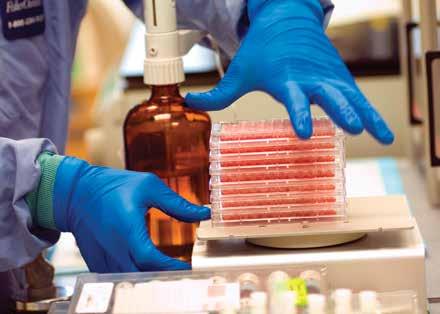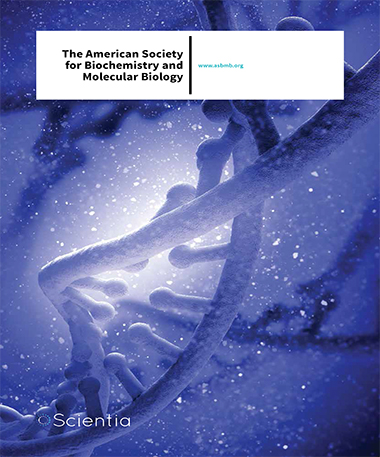The American Society For Biochemistry And Molecular Biology
 Representing over 12,000 members worldwide, the American Society for Biochemistry and Molecular Biology (ASBMB) has been advancing the fields of biochemistry and molecular biology for the last 100 years. Over the next few pages we have had the pleasure of speaking with Dr Erica Siebrasse, Education & Professional Development Manager at the ASBMB, who tells us all about the organisation. From disseminating the latest scientific research to increasing science literacy and promoting cultural diversity in these disciplines, here we gain great insight into the organisation’s activities.
Representing over 12,000 members worldwide, the American Society for Biochemistry and Molecular Biology (ASBMB) has been advancing the fields of biochemistry and molecular biology for the last 100 years. Over the next few pages we have had the pleasure of speaking with Dr Erica Siebrasse, Education & Professional Development Manager at the ASBMB, who tells us all about the organisation. From disseminating the latest scientific research to increasing science literacy and promoting cultural diversity in these disciplines, here we gain great insight into the organisation’s activities.
 To start, please tell us what ASBMB is all about. How was the society founded and what is its mission?
To start, please tell us what ASBMB is all about. How was the society founded and what is its mission?
The ASBMB is a non-profit scientific and educational organisation with over 12,000 members. It was founded in 1906 as the American Society of Biological Chemists by a small group of biochemists, many of whom had participated in the launch of the Journal of Biological Chemistry in 1905. The society advances the science of biochemistry and molecular biology by publishing scientific journals, organising scientific meetings, advocating on Capitol Hill for basic research, supporting science education, and promoting the diversity of individuals in the discipline.
What are the benefits of being an ASBMB member? Are there any grants and scholarships available that our readers might be interested in applying for?
The ASBMB has supported the careers and research of biochemists and molecular biologists for more than 100 years. All members receive access to top research through subscriptions to the society’s three journals and the member magazine, and regular members receive substantial publication discounts. All members also receive registration discounts to society meetings, including the annual meeting, specialised small meetings and career workshops. The ASBMB offers substantial and numerous travel awards to the annual meeting and connects thousands of undergraduate students and faculty through its Student Chapters program. Student Chapters provides grants and scholarships to support education, research and outreach. Finally, the society offers members excellent online and in-person career resources.
Tell us about ASBMB’s goal to increase cultural diversity within the fields of Biochemistry and Molecular Biology, and give examples of how the society is actively achieving this.
The Minority Affairs Committee (MAC) leads the ASBMB’s efforts to promote diversity in biochemistry and molecular biology. The MAC sponsors a National Science Foundation-funded annual grant-writing workshop for early-career scientists preparing for independent positions, a transition shown to be a critical step in long-term success. The committee supports underrepresented students through travel awards to the annual meeting and undergraduate scholarships for students who enhance the diversity of science. The MAC also highlights scientists from underrepresented backgrounds in the ‘Research Spotlight’ interview series and connects those interested in promoting diversity within the community through the ‘Partnership for Diversity’. Finally, the committee recognises scientists committed to diversity and effective mentorship of underrepresented students with the annual Ruth Kirschstein Diversity in Science award.
Tell us a bit about your journals, and the types of research you publish in each one.
The ASBMB publishes three journals: the Journal of Biological Chemistry, Molecular & Cellular Proteomics and the Journal of Lipid Research. The JBC is one of the top-cited journals in the world and is the most significant contributor to the field of biochemistry and molecular biology. It also boasts a rapid review time. MCP fosters the development and applications of proteomics in both basic and translation research. It showcases cutting-edge advances in proteomics, metabolomics and bioinformatics. Finally, the JLR focuses on the science of lipids in health and disease. It publishes new insights into mechanisms of lipid function and metabolism and/or genes regulating lipid metabolism. All three journals have no submission fees, and authors receive fair, thorough and constructive peer review from practicing scientists.
 What is the Public Affairs Advisory Committee (PAAC) of the ASBMB, and what exactly do they do?
What is the Public Affairs Advisory Committee (PAAC) of the ASBMB, and what exactly do they do?
The PAAC advocates on behalf of ASBMB members to lawmakers and federal science agencies and advises society leadership on public affairs issues. The committee supports and trains ASBMB members to engage with their congressional representatives by sponsoring an annual Capitol Hill day and the ‘August is for Advocacy’ event, among other events. It also supports science-policy training through its fellowship program, which brings PhD-level scientists to work with the public affairs team at our headquarters. The society maintains a policy blog and contributes regular articles in the member magazine to keep members informed of policy issues affecting them. Finally, the PAAC supports the Howard K. Schachman Public Service Award, which recognises an individual who best demonstrates dedication to public service in support of biomedical science.
Describe some of the many other ways that ASBMB supports Biochemistry and Molecular Biology research and education in the US and further afield.
Beyond the many member benefits, publications, meetings, advocacy and diversity efforts already mentioned, the ASBMB is a leader in biochemistry and molecular biology education, professional development and community outreach.
The ASBMB Education and Professional Development Committee leads several initiatives that demonstrate the society’s commitment to education, including the accreditation and concept-driven teaching programs. The ASBMB accredits departments and programs that offer bachelor’s degrees in biochemistry, molecular biology or related subjects. ASBMB accreditation recognises programs whose features and infrastructure fulfil the basic expectations of the society. The society recently ended an NSF-funded concept-driven teaching project that brought together experienced and early-career educators to learn about and develop resources for course materials, assessment tools and teaching the foundational concepts of biochemistry and molecular biology. The ASBMB Student Chapters program, led by a steering committee of the same name, provides networking and career-development opportunities, access to research and science outreach, as well as grants and awards to facilitate these aims to more than 2,000 undergraduate student and faculty members.
‘The ASBMB is a leader in biochemistry and molecular biology education, professional development and community outreach’

Over the past year, the EPD has created a new set of excellent career resources to better serve members’ professionaldevelopment needs. The society maintains a job board and a careers blog that rounds up job opportunities in specific subfields. The EPD also offers career-development training through webinars, video tutorials, online courses, articles and in-person workshops, all of which are either complimentary or low cost. Those interested in careers in biochemistry and molecular biology can learn about jobs through a comprehensive set of online resources. Finally, the ASBMB maintains a national online database of summer research opportunities for undergraduates.
The ASBMB has shown its commitment to science literacy through the work of its Public Outreach Committee, which provides training, resources and opportunities for ASBMB members to get involved with informal education and science outreach in their local communities. In addition to providing funds to support outreach efforts, the committee maintains a database of outreach opportunities, hosts outreach and training events and offers communication training and online outreach resources.
Finally, what do you see as the biggest challenges to Biochemistry and Molecular Biology research worldwide within the next 10 years?
Consistent funding and support for basic biomedical research is necessary to maintain and build upon the excellent biochemistry and molecular biology research of the past. Economic issues have challenged many countries to adequately support basic science and its workforce. The need to continually write grants and publish papers constrains the amount of time investigators have to train the future generation of scientists, who are faced with a challenging job market. While unemployment rates for scientists remain low, the vast majority of PhD-level scientists will not land tenuretrack positions, although most are still trained (sometimes exclusively) for this path. Efforts to broaden training experiences are increasing, especially in the US. Despite these challenges, the biochemistry and molecular biology community continues to produce ground-breaking discoveries.

